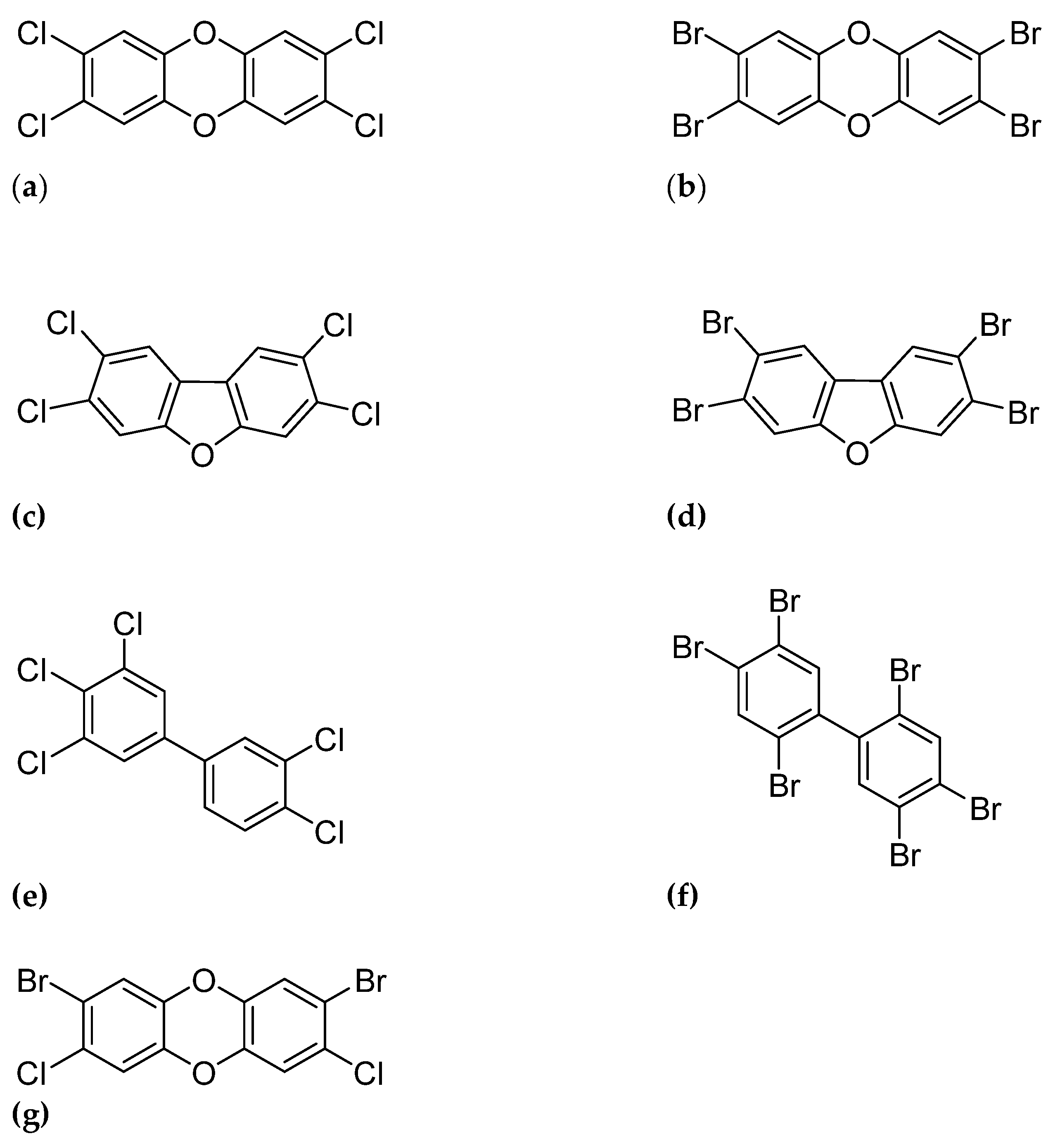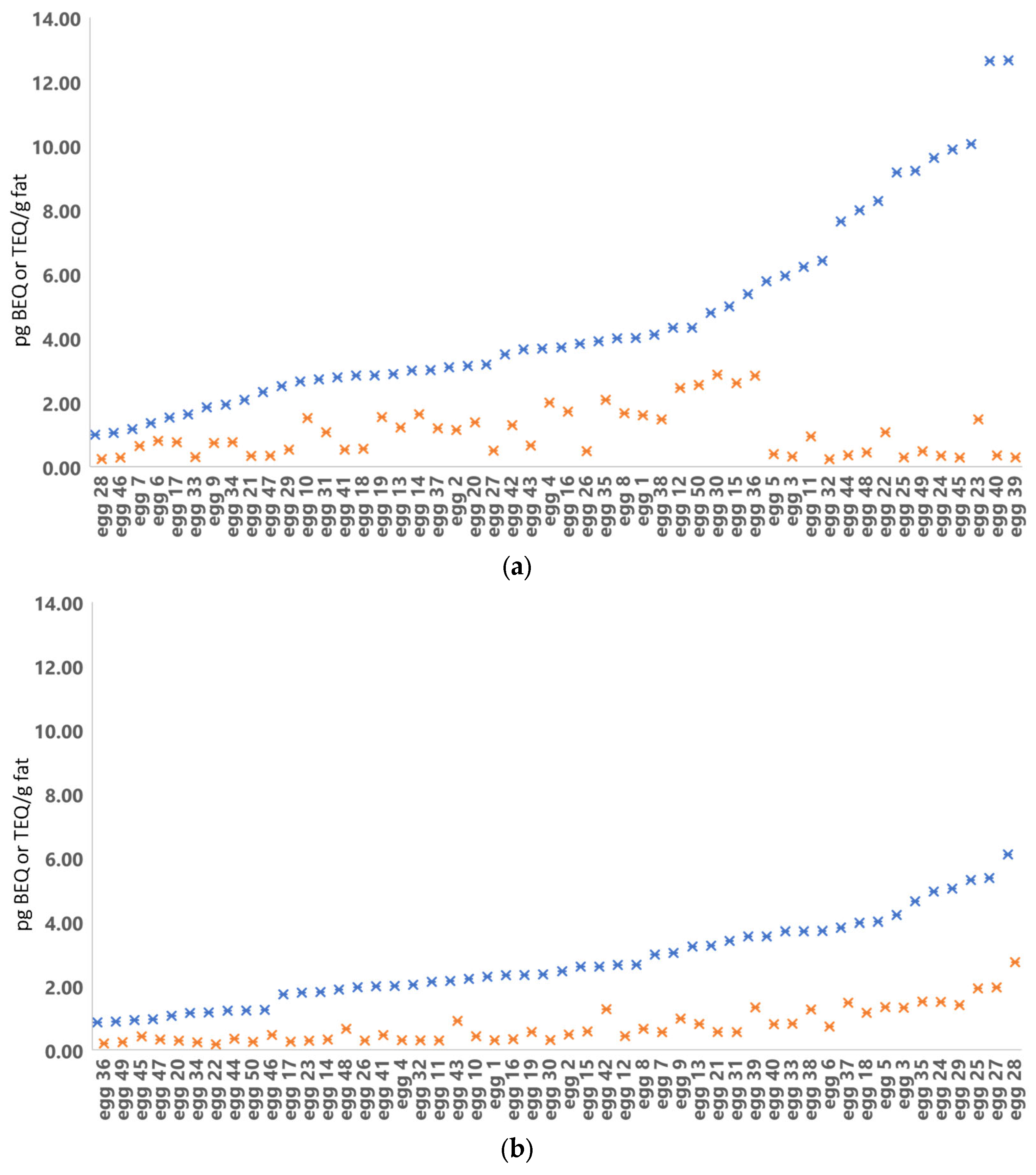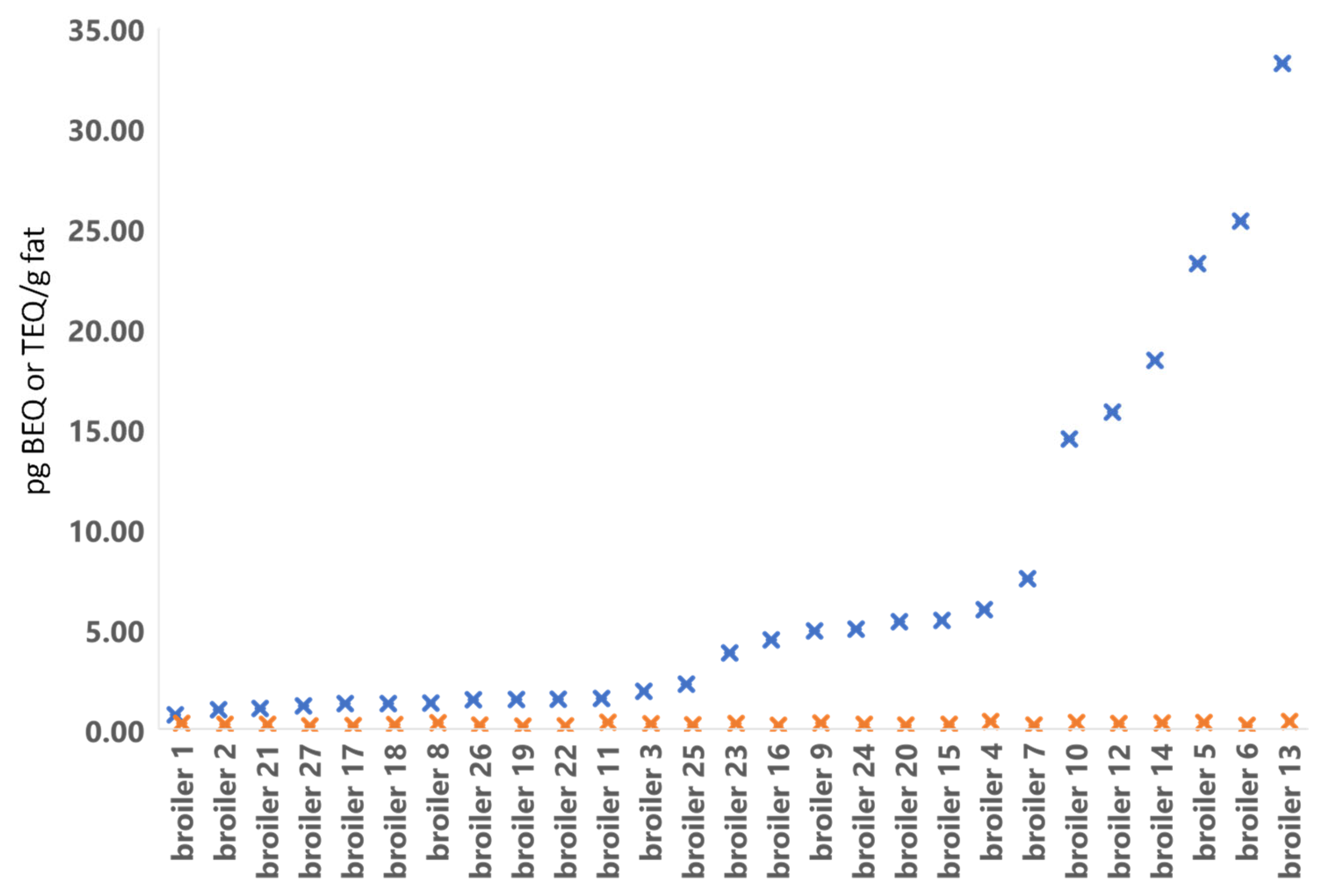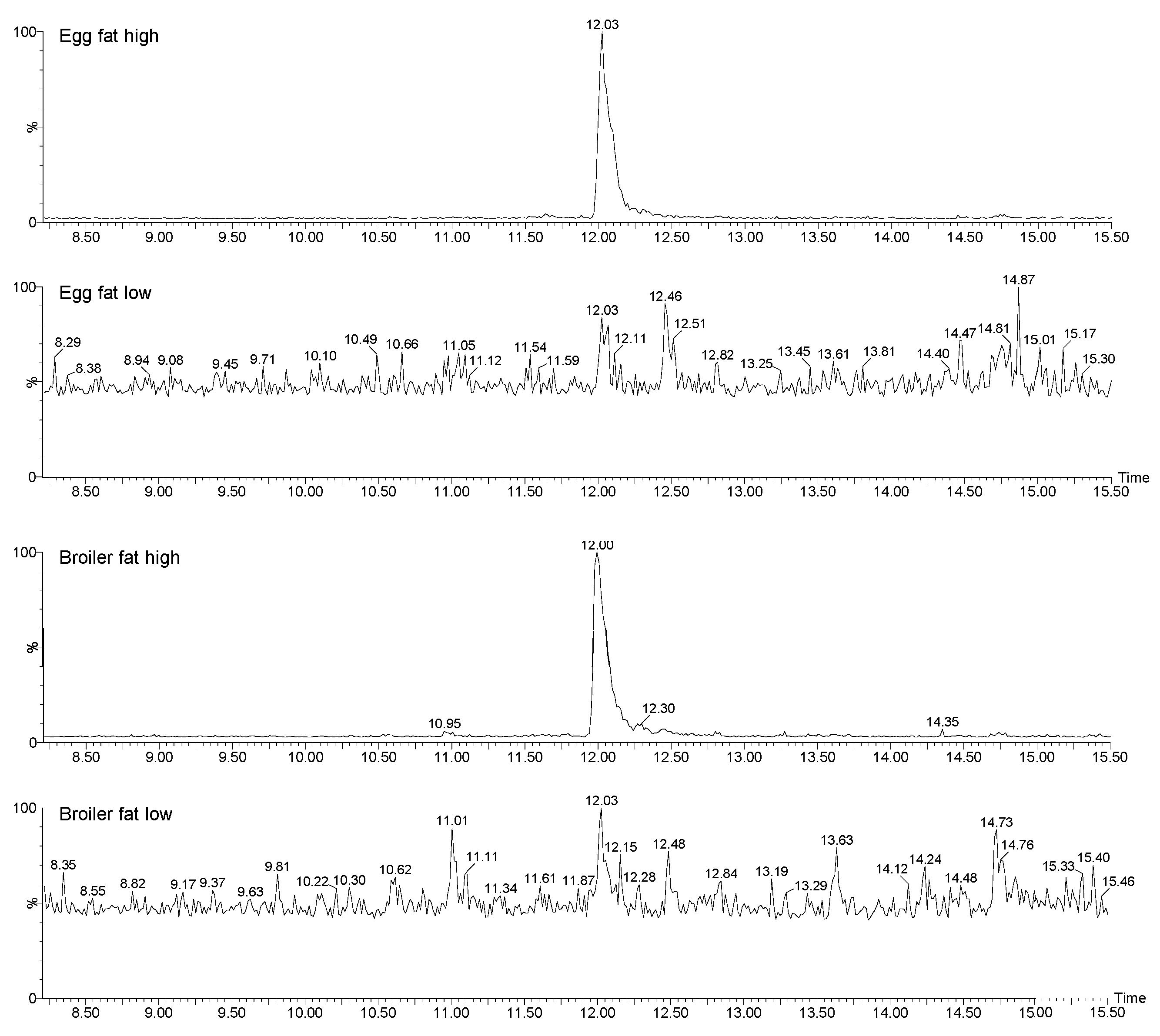Brominated Dioxins in Egg, Broiler, and Feed Additives: Significance of Bioassay-Directed Screening for Identification of Emerging Risks in Food
Abstract
1. Introduction
2. Materials and Methods
2.1. Samples
2.2. Chemicals
2.3. Sample Preparation
2.4. Sample Cleanup and Routine DR CALUX Screening
2.5. Sample Cleanup for GC-HRMS and for Additional Screening with the DR CALUX Bioassay
2.6. GC-HRMS Analysis
2.7. Determination of the Relative Potency (REP) of 2,3,7,8-TBDF in the DR CALUX Bioassay
2.8. Feed–Food Converter
3. Results and Discussion
3.1. Screening and Analysis of PCDD/Fs in Egg and Broiler
3.2. Screening and Analysis of PCDD/Fs in Egg and Broiler Pool Samples
3.3. GC-HRMS Analysis of PBDD/Fs and Mixed Chlorinated-Brominated PXDD/Fs
3.4. Determination of the REP of 2,3,7,8-TBDF in the DR CALUX Bioassay
3.5. Eliciting the Source of the 2,3,7,8-TBDF Contamination
3.6. Feed-to-Food Converter
4. Conclusions
Author Contributions
Funding
Institutional Review Board Statement
Informed Consent Statement
Data Availability Statement
Conflicts of Interest
References
- Kan, C.A.; Meijer, G.A.L. The risk of contamination of food with toxic substances present in animal feed. Anim. Feed. Sci. Technol. 2007, 133, 84–108. [Google Scholar] [CrossRef]
- Tóth, G.; Hermann, T.; Da Silva, M.; Montanarella, L. Heavy metals in agricultural soils of the European Union with implications for food safety. Environ. Int. 2016, 88, 299–309. [Google Scholar] [CrossRef]
- Oplatowska-Stachowiak, M.; Elliott, C.T. Food colors: Existing and emerging food safety concerns. Crit. Rev. Food Sci. Nutr. 2017, 57, 524–548. [Google Scholar] [CrossRef] [PubMed]
- Gerssen, A.; Bovee, T.H.; van Ginkel, L.A.; van Iersel, M.L.; Hoogenboom, R.L. Food and feed safety: Cases and approaches to identify the responsible toxins and toxicants. Food Control 2019, 98, 9–18. [Google Scholar] [CrossRef]
- Hites, R.A. Dioxins: An Overview and History. Environ. Sci. Technol. 2011, 45, 16–20. [Google Scholar] [CrossRef]
- Horii, Y.; van Bavel, B.; Kannan, K.; Petrick, G.; Nachtigall, K.; Yamashita, N. Novel evidence for natural formation of dioxins in ball clay. Chemosphere 2008, 70, 1280–1289. [Google Scholar] [CrossRef] [PubMed]
- Van Den Berg, M.; Birnbaum, L.S.; Denison, M.; De Vito, M.; Farland, W.; Feeley, M.; Fiedler, H.; Håkansson, H.; Hanberg, A.; Haws, L.; et al. The 2005 World Health Organization reevaluation of human and Mammalian toxic equivalency factors for dioxins and dioxin-like compounds. Toxicol. Sci. 2006, 93, 223–241. [Google Scholar] [CrossRef] [PubMed]
- Hoogenboom, L.; Traag, W.; Bovee, T.; Goeyens, L.; Carbonnelle, S.; Vanloco, J.; Beernaert, H.; Jacobs, G.; Schoeters, G.; van Loco, J.; et al. The CALUX bioassay: Current status of its application to screening food and feed. TrAC Trends Anal. Chem. 2006, 25, 410–420. [Google Scholar] [CrossRef]
- Larigot, L.; Juricek, L.; Dairou, J.; Coumoul, X. AhR signaling pathways and regulatory functions. Biochim. Open 2018, 7, 1–9. [Google Scholar] [CrossRef] [PubMed]
- Malisch, R.; Kotz, A. Dioxins and PCBs in feed and food—Review from European perspective. Sci. Total Environ. 2014, 491–492, 2–10. [Google Scholar] [CrossRef]
- Srogi, K. Levels and congener distributions of PCDDs, PCDFs and dioxin-like PCBs in environmental and human samples: A review. Environ. Chem. Lett. 2008, 6, 1–28. [Google Scholar] [CrossRef]
- Ssebugere, P.; Sillanpää, M.; Matovu, H.; Mubiru, E. Human and environmental exposure to PCDD/Fs and dioxin-like PCBs in Africa: A review. Chemosphere 2019, 223, 483–493. [Google Scholar] [CrossRef] [PubMed]
- Behnisch, P.A.; Hosoe, K.; Sakai, S. Brominated dioxin-like compounds: In vitro assessment in comparison to classical dioxin-like compounds and other polyaromatic compounds. Environ. Int. 2003, 29, 861–877. [Google Scholar] [CrossRef]
- van den Berg, M.; Denison, M.S.; Birnbaum, L.S.; Devito, M.J.; Fiedler, H.; Falandysz, J.; Rose, M.; Schrenk, D.; Safe, S.; Tohyama, C.; et al. Polybrominated dibenzo-p-dioxins, dibenzofurans, and biphenyls: Inclusion in the toxicity equivalency factor concept for dioxin-like compounds. Toxicol. Sci. 2013, 133, 197–208. [Google Scholar] [CrossRef]
- Budin, C.; Petrlik, J.; Strakova, J.; Hamm, S.; Beeler, B.; Behnisch, P.; Besselink, H.; van der Burg, B.; Brouwer, A. Detection of high PBDD/Fs levels and dioxin-like activity in toys using a combination of GC-HRMS, rat-based and human-based DR CALUX® reporter gene assays. Chemosphere 2020, 251, 126579. [Google Scholar] [CrossRef]
- Birnbaum, L.S.; Staskal, D.F.; Diliberto, J.J. Health effects of polybrominated dibenzo-p-dioxins (PBDDs) and dibenzofurans (PBDFs). Environ. Int. 2003, 29, 855–860. [Google Scholar] [CrossRef] [PubMed]
- Fromme, H.; Hilger, B.; Albrecht, M.; Gries, W.; Leng, G.; Völkel, W. Occurrence of chlorinated and brominated dioxins/furans, PCBs, and brominated flame retardants in blood of German adults. Int. J. Hyg. Environ. Health 2016, 219, 380–388. [Google Scholar] [CrossRef] [PubMed]
- Yang, J.; Yu, H.; Xie, Z.; Yang, Y.; Zheng, X.; Zhang, J.; Huang, Q.; Wen, T.; Wang, J. Pathways and influential factors study on the formation of PBDD/Fs during co-processing BDE-209 in cement kiln simulation system. Ecotoxicol. Environ. Saf. 2020, 192, 110246. [Google Scholar] [CrossRef]
- Hanari, N.; Kannan, K.; Miyake, Y.; Okazawa, T.; Kodavanti, P.R.; Aldous, K.M.; Yamashita, N. Occurrence of polybrominated biphenyls, polybrominated dibenzo-p-dioxins, and polybrominated dibenzofurans as impurities in commercial polybrominated diphenyl ether mixtures. Environ. Sci. Technol. 2006, 40, 4400–4405. [Google Scholar] [CrossRef]
- Schlummer, M.; Mäurer, A.; Leitner, T.; Spruzina, W. Report: Recycling of flame-retarded plastics from waste electric and electronic equipment (WEEE). Waste Manag. Res. 2006, 24, 573–583. [Google Scholar] [CrossRef]
- Fernandes, A.R.; Lake, I.R.; Dowding, A.; Rose, M.; Jones, N.R.; Smith, F.; Panton, S. The transfer of environmental contaminants (Brominated and Chlorinated dioxins and biphenyls, PBDEs, HBCDDs, PCNs and PFAS) from recycled materials used for bedding to the eggs and tissues of chickens. Sci. Total Environ. 2023, 892, 164441. [Google Scholar] [CrossRef]
- Fernandes, A.; D’Silva, K.; Driffield, M.; White, S.; Rose, M. Brominated Flame Retardants and Brominated Dioxins in 2003 Total Diet Samples; Report FD-04/37; Report to the Food Standards Agency: London, UK, 2005.
- Fernandes, A.; Lake, I.; Dowding, A.; Rose, M.; Jones, N.; Petch, R.; Smith, F.; Panton, S. The potential of recycled materials used in agriculture to contaminate food through uptake by livestock. Sci. Total Environ. 2019, 667, 359–370. [Google Scholar] [CrossRef] [PubMed]
- Mwangi, J.K.; Lee, W.-J.; Wang, L.-C.; Sung, P.-J.; Fang, L.-S.; Lee, Y.-Y.; Chang-Chien, G.-P. Persistent organic pollutants in the Antarctic coastal environment and their bioaccumulation in penguins. Environ. Pollut. 2016, 216, 924–934. [Google Scholar] [CrossRef] [PubMed]
- Bjurlid, F.; Kärrman, A.; Ricklund, N.; Hagberg, J. Occurrence of brominated dioxins in a study using various firefighting methods. Sci. Total Environ. 2017, 599–600, 1213–1221. [Google Scholar] [CrossRef]
- Zacs, D.; Rjabova, J.; Bartkevics, V. Occurrence of brominated persistent organic pollutants (PBDD/DFs, PXDD/DFs, and PBDEs) in Baltic wild salmon (Salmo salar) and correlation with PCDD/DFs and PCBs. Environ. Sci. Technol. 2013, 47, 9478–9486. [Google Scholar] [CrossRef] [PubMed]
- Fernandes, A.R.; Falandysz, J. Polybrominated dibenzo-p-dioxins and furans (PBDD/Fs): Contamination in food, humans and dietary exposure. Sci. Total Environ. 2021, 761, 143191. [Google Scholar] [CrossRef]
- World Health Organization. Dioxins and Their Effects on Human Health; WHO factsheet; WHO: Geneva, Switzerland, 2016. [Google Scholar]
- Pajurek, M.; Pietron, W.; Maszewski, S.; Mikolajczyk, S.; Piskorska-Pliszczynska, J. Poultry eggs as a source of PCDD/Fs, PCBs, PBDEs and PBDD/Fs. Chemosphere 2019, 223, 651–658. [Google Scholar] [CrossRef] [PubMed]
- Fernandes, A.; Tlustos, C.; Smith, F.; Carr, M.; Petch, R.; Rose, M. Polybrominated diphenylethers (PBDEs) and brominated dioxins (PBDD/Fs) in Irish food of animal origin. Food Addit. Contam. Part B 2009, 2, 86–94. [Google Scholar] [CrossRef]
- Watanabe, K.; Senthilkumar, K.; Masunaga, S.; Takasuga, T.; Iseki, N.; Morita, M. Brominated Organic Contaminants in the Liver and Egg of the Common Cormorants (Phalacrocorax carbo) from Japan. Environ. Sci. Technol. 2004, 38, 4071–4077. [Google Scholar] [CrossRef]
- Malisch, R. Incidents with Dioxins and PCBs in Food and Feed-Investigative Work, Risk Management and Economic Consequences. J. Environ. Prot. 2017, 8, 42. [Google Scholar] [CrossRef]
- Waguespack, A.M.; Powell, S.; Bidner, T.D.; Payne, R.L.; Southern, L.L. Effect of incremental levels of L-lysine and determination of the limiting amino acids in low crude protein corn-soybean meal diets for broilers1. Poult. Sci. 2009, 88, 1216–1226. [Google Scholar] [CrossRef] [PubMed]
- Jespersen, J.C.; Richert, S.; Dorigam, J.C.D.P.; Oelschlager, M.L.; Dilger, R.N. Effects of lysine biomass supplementation on growth performance and clinical indicators in broiler chickens. Poult. Sci. 2021, 100, 100971. [Google Scholar] [CrossRef] [PubMed]
- Gous, R.; Morris, T. Evaluation of a diet dilution technique for measuring the response of broiler chickens to increasing concentrations of lysine. Br. Poult. Sci. 1985, 26, 147–161. [Google Scholar] [CrossRef] [PubMed]
- Igwe, I.R.; Okonkwo, C.J.; Uzoukwu, U.G.; Onyenegecha, C.O. The Effect of Choline Chloride on the Performance of Broiler Chickens. Annu. Res. Rev. Biol. 2015, 8, 1–8. [Google Scholar] [CrossRef]
- Hahladakis, J.N.; Velis, C.A.; Weber, R.; Iacovidou, E.; Purnell, P. An overview of chemical additives present in plastics: Migration, release, fate and environmental impact during their use, disposal and recycling. J. Hazard. Mater. 2018, 344, 179–199. [Google Scholar] [CrossRef]
- Dam, G.T.; Pussente, I.C.; Scholl, G.; Eppe, G.; Schaechtele, A.; van Leeuwen, S. The performance of atmospheric pressure gas chromatography-tandem mass spectrometry compared to gas chromatography-high resolution mass spectrometry for the analysis of polychlorinated dioxins and polychlorinated biphenyls in food and feed samples. J. Chromatogr. A 2016, 1477, 76–90. [Google Scholar]
- Smedes, F. Determination of Total Lipid Using Non-Chlorinated Solvents. Analyst 1999, 124, 1711–1718. [Google Scholar] [CrossRef]
- Akuamoa, F.; Hoogenboom, R.L.; Weide, Y.; van der Weg, G.; Rietjens, I.M.; Bovee, T.F. Presence and risks of polycyclic aromatic hydrocarbons, dioxins and dioxin-like PCBs in dietary plant supplements as elucidated by a combined DR CALUX® bioassay and GC-HRMS based approach. Food Addit. Contam. Part A 2022, 39, 1576–1590. [Google Scholar] [CrossRef] [PubMed]
- Notenboom, S.; Punt, A.; Hoogenveen, R.; Zeilmaker, M.J.; Hoogenboom, R.L.A.P.; Bokkers, B.G.H. A congener-specific modelling approach for the transfer of polychlorinated dibenzo-p-dioxins and dibenzofurans and dioxin-like polychlorinated biphenyls from feed to eggs of laying hens. Food Addit. Contam. Part A 2023, 40, 96–109. [Google Scholar] [CrossRef]
- Zhou, Y.; van Leeuwen, S.P.; Knobloch, M.; Dirks, C.; Weide, Y.; Bovee, T.F. Impurities in technical mixtures of chlorinated paraffins show AhR agonist properties as determined by the DR-CALUX bioassay. Toxicol. Vitr. 2021, 72, 105098. [Google Scholar] [CrossRef]






| Congener | Elemental Composition | Qualifier (m/z) | Quantifier (m/z) | Internal Standard | Qualifier (m/z) |
|---|---|---|---|---|---|
| 1,3,7-Tribromodibenzofuran | C12H5Br3O | 403.788 | 405.785 | 13C-2,3,7,8-TBDF | 491.723 |
| 2,3,7,8-TBDF | C12H4Br4O | 483.695 | 481.697 | 13C-2,3,7,8-TBDF | 491.723 |
| 1,2,3,7,8-PeBDF | C12H3Br5O | 561.606 | 563.604 | 13C-1,2,3,7,8-PeBDF | 569.633 |
| 2,3,4,7,8-PeBDF | C12H3Br5O | 561.606 | 563.604 | 13C-2,3,4,7,8-PeBDF | 569.633 |
| 1,2,3,4,7,8-HxBDF | C12H2Br6O | 641.514 | 643.512 | 13C-1,2,3,4,7,8-HxBDF | 649.542 |
| 1,2,3,4,6,7,8-HpBDF | C12H1Br7O | 719.425 | 721.423 | 13C-1,2,3,4,6,7,8-HpBDF | 727.452 |
| OBDF | C12Br8O | 799.333 | 797.335 | 13C-1,2,3,4,6,7,8-HpBDF | 727.452 |
| 1,3,7-Tribromodibenzo-p-dioxin | C12H5Br3O2 | 419.782 | 421.780 | 13C-2,3,7,8-TBDD | 507.718 |
| 2,3,7,8-TBDD | C12H4Br4O2 | 499.690 | 497.692 | 13C-2,3,7,8-TBDD | 507.718 |
| 1,2,3,7,8-PeBDD | C12H3Br5O2 | 577.600 | 579.598 | 13C-1,2,3,7,8-PeBDD | 585.628 |
| 1,2,3,4,7,8-1,2,3,6,7,8-HxBDD | C12H2Br6O2 | 657.509 | 655.511 | 13C-1,2,3,7,8,9-HxBDD | 665.537 |
| 1,2,3,7,8,9-HxBDD | C12H2Br6O2 | 657.509 | 655.511 | 13C-1,2,3,4,7,8-HxBDD | 665.537 |
| 1,2,3,4,6,7,8-HpBDD | C12H1Br7O2 | 735.419 | 737.417 | 13C-1,2,3,4,6,7,8-HpBDD | 743.447 |
| OBDD | C12Br8O2 | 815.328 | 813.330 | 13C-OBDD | 823.356 |
| Congener | Elemental Composition | Qualifier (m/z) | Quantifier (m/z) | Internal Standard | Qualifier (m/z) |
|---|---|---|---|---|---|
| 2,8-dibromo-3,7-dichloro-dibenzo-p-dioxin | C12H4Br2Cl2O2 | 409.7933 | 411.791 | 13C-2,3,7,8-TBDF | 491.723 |
| 8-bromo-2,3,4-trchlorodibenzofuran | C12H4BrCl3O | 349.8487 | 351.846 | 13C-2,3,7,8-TBDF | 491.723 |
| 4-bromo-2,4,7,8-tetrachlorodibenzofuran | C12H3BrCl4O | 383.8096 | 385.8069 | 13C-1,2,3,7,8-PeBDF | 569.633 |
| 2-bromo-3,7,8-trichlorodibenzofuran | C12H4BrCl3O | 349.8487 | 351.846 | 13C-2,3,4,7,8-PeBDF | 569.633 |
| 2-bromo-1,3,7,8,-tetrachlorodibenzofuran | C12H3BrCl4O | 383.8096 | 385.8069 | 13C-1,2,3,4,7,8-HxBDF | 649.542 |
| 2,3-dibromo-7,8-dichlorodibenzo-p-dioxin | C12H4Br2Cl2O2 | 409.7933 | 411.791 | 13C-1,2,3,4,6,7,8-HpBDF | 727.452 |
| 2-bromo-1,3,7,8,-tetrachlorodibenzo-p-dioxin | C₁₂H₃BrCl₄O₂ | 399.8045 | 401.8019 | 13C-1,2,3,4,6,7,8-HpBDF | 727.452 |
| Sample | DR CALUX Result | Assessment |
|---|---|---|
| Eggs low | 0.55 pg BEQ/g | Negative |
| Eggs high | 10.45 pg BEQ/g | Suspect |
| Broiler low | 0.02 pg BEQ/g | Negative |
| Broiler high | 18.58 pg BEQ/g | Suspect |
| Sample Type | DR CALUX ng BEQ/kg | GC/HRMS PCDD/Fs + PCBs ng TEQ/kg | GC/HRMS PBDD/F pg/g Fat/Product | ||||||
|---|---|---|---|---|---|---|---|---|---|
| 2,3,7,8 TBDF | 1,2,3,7,8 PeBDF | 2,3,4,7,8 PeBDF | 1,2,3,4,7,8HxBDF | 1,2,3,4,6,7,8HpBDF | 2,3,7,8 TBDD | 1,2,3,7,8,9HxBDD | |||
| Broiler fat (pool) high | 19 | 0.03 | 31 | 1 | 1 | 1 | 1 | 1 | 1 |
| Broiler fat (pool) low | 0.02 | ||||||||
| Egg fat (pool) high | 10 | 0.16 | 21 | 1 | 1 | 1 | 1 | 1 | 1 |
| Egg fat (pool) low | 0.55 | ||||||||
| Choline chloride | 1 | 0.045 | 0.23 | 1 | 1 | 1 | 1 | 1 | 1 |
| Choline chloride | 3 | 0.044 | 3.13 | 0.41 | 1 | 1 | 1 | 1 | 1 |
| Poultry feed | 4 | 0.103 | 3.6 | 1 | 1 | 1 | 1 | 1 | 1 |
| L-lysine | 7 | 0.039 | 1.86 | 1.59 | 1 | 1.04 | 1 | 1 | 1 |
| L-lysine | 15 | 0.449 | 2.39 | 1.71 | 0.26 | 0.25 | 1 | 1 | 1 |
| L-lysine | 16 | 0.155 | 4.92 | 1.47 | 0.26 | 2 | 0.21 | 1 | 0.08 |
| L-lysine | 19 | 0.062 | 5.34 | 2.09 | 0.31 | 1 | 1 | 1 | 1 |
| L-lysine | 22 | 0.248 | 8.33 | 2.53 | 0.27 | 1.11 | 0.15 | 1 | 1 |
| L-lysine | 22 | 0.508 | 8.8 | 3.53 | 0.62 | 0.61 | 1 | 1 | 1 |
| L-lysine | 45 | 0.243 | 22.3 | 0.13 | 1 | 1 | 1 | 0.05 | 1 |
| Bedding material | 750 | 143 | 1 | 1 | 1 | 1 | 1 | 1 | 1 |
| Seaweed (me hijiki) | 2.24 | 0.15 | 1 | 1 | 1 | 1 | 1 | 1 | 1 |
| Butter fat 0.5 | 0.59 | 0.36 | 1 | 1 | 1 | 1 | 1 | 1 | 1 |
| Butter fat 6.0 | 6.19 | 4.5 | 1 | 1 | 1 | 1 | 1 | 1 | 1 |
Disclaimer/Publisher’s Note: The statements, opinions and data contained in all publications are solely those of the individual author(s) and contributor(s) and not of MDPI and/or the editor(s). MDPI and/or the editor(s) disclaim responsibility for any injury to people or property resulting from any ideas, methods, instructions or products referred to in the content. |
© 2024 by the authors. Licensee MDPI, Basel, Switzerland. This article is an open access article distributed under the terms and conditions of the Creative Commons Attribution (CC BY) license (https://creativecommons.org/licenses/by/4.0/).
Share and Cite
Dirks, C.; Gerssen, A.; Weide, Y.; Meijer, T.; van der Weg, G.; van de Schans, M.G.M.; Bovee, T.F.H. Brominated Dioxins in Egg, Broiler, and Feed Additives: Significance of Bioassay-Directed Screening for Identification of Emerging Risks in Food. Foods 2024, 13, 931. https://doi.org/10.3390/foods13060931
Dirks C, Gerssen A, Weide Y, Meijer T, van der Weg G, van de Schans MGM, Bovee TFH. Brominated Dioxins in Egg, Broiler, and Feed Additives: Significance of Bioassay-Directed Screening for Identification of Emerging Risks in Food. Foods. 2024; 13(6):931. https://doi.org/10.3390/foods13060931
Chicago/Turabian StyleDirks, Caroline, Arjen Gerssen, Yoran Weide, Thijs Meijer, Guido van der Weg, Milou G. M. van de Schans, and Toine F. H. Bovee. 2024. "Brominated Dioxins in Egg, Broiler, and Feed Additives: Significance of Bioassay-Directed Screening for Identification of Emerging Risks in Food" Foods 13, no. 6: 931. https://doi.org/10.3390/foods13060931
APA StyleDirks, C., Gerssen, A., Weide, Y., Meijer, T., van der Weg, G., van de Schans, M. G. M., & Bovee, T. F. H. (2024). Brominated Dioxins in Egg, Broiler, and Feed Additives: Significance of Bioassay-Directed Screening for Identification of Emerging Risks in Food. Foods, 13(6), 931. https://doi.org/10.3390/foods13060931





